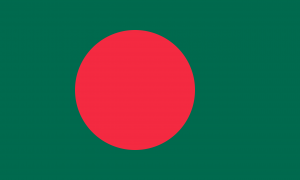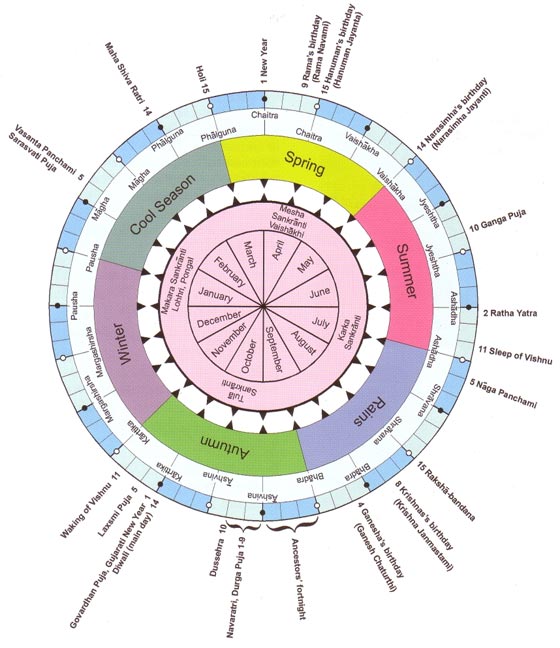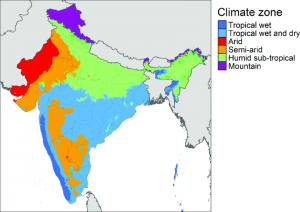Language/Bengali/Vocabulary/Seasons
The Bengali luni-solar calendar, which has its roots in Vedic times, recognizes six distinct seasons, referred to as "ritus." This calendar system has been widely used by Hindus across Bengal and India to organize their daily lives and mark important festivals and religious events. Each of the six seasons lasts for a period of two months and is characterized by special celebrations and observances. Despite the advent of modern-day calendars, the luni-solar Bengali calendar remains in use among Hindu communities, who continue to hold it in high regard for its cultural and religious significance.
Take a moment to explore these relevant pages as you conclude this lesson: How to say Good Bye? & Airport.
According to Hindu scriptures, the six seasons are:
6 seasons[edit | edit source]
| Season in Bengali (writing) | Seasons in Bengali (pronunciation) | Seasons (English) | Months (Begins - Ends) English | Months in Bengali (writing) | Months in Bengali (pronunciation) |
|---|---|---|---|---|---|
| গ্রীষ্ম | Grishmo | Summer | Mid April - Mid June | বৈশাখ-জ্যৈষ্ঠ | Boishakh - Joishto |
| বর্ষা | Bôrsha | Wet season|Rainy (Monsoon) | Mid June - Mid August | আষাঢ়-শ্রাবণ | Ashar - Shrabon |
| শরৎ | Shôrot | Autumn | Mid August - Mid October | ভাদ্র-আশ্বিন | Vadro - Ashwin |
| হেমন্ত | Hemonto | Dry season|Late Autumn | Mid October - Mid December | কার্তিক-অগ্রহায়ণ | Kartik - Ogrohayon |
| শীত | Šheet | Winter | Mid December - Mid February | পৌষ-মাঘ | Poush - Maagh |
| বসন্ত | Bôshonto | Spring | Mid February - Mid April | ফাল্গুন-চৈত্র | Falgun - Choitro |
The Climates of India[edit | edit source]
A continental country representing a territory as vast as Europe, India has very varied climates depending on the region and altitude. India has three main seasons: winter, summer, and the monsoon season (or rainy season).
The winter months (November to March) are pleasant throughout India (excluding the Himalayan regions): clear and sunny days. In the northern plains, it often happens that the temperature drops sharply. At the same time, it is snowing in the Himalayan mountains. In southern India, the months of December and January are cool without ever getting really cold. In the east, showers and snow are common from mid-December to February.
The summer months (April to June) are very hot over almost the entire surface of the country, but in the mountainous regions to the north, such as Ladakh, the climate remains quite cool. The monsoon period varies depending on the region: - In the south: from June to August in Kerala and from October to November in Tamil Nadu - In the east: from May to mid-October (showers always possible even during winter), We can thus travel all year round in India, depending on the monsoons and reversed seasons that affect the country. The months of May-June and September-October are periods of climatic transition.
Video[edit | edit source]
Sources[edit | edit source]
- https://www.facebook.com/aahar.bengali/posts/six-seasons-of-the-bengali-hindu-indian-calendaraccording-to-the-luni-solar-beng/809606385896395/
- https://www.ritiriwaz.com/the-hindu-calendar-has-6-seasons/
- https://www.researchgate.net/figure/Major-climate-zones-in-India-based-on-Koeppen-Geiger-climate-classification-Mountain_fig2_340572318
Videos[edit | edit source]
Vocabulary - seasons - summer, monsoon, autumn, winter (Bengali ...[edit | edit source]
Other Lessons[edit | edit source]
- Fruits
- Education
- Flowers
- Clothes
- Months of the year
- Feelings and Emotions
- Count to 10
- Airport
- Drinks
- Colors



